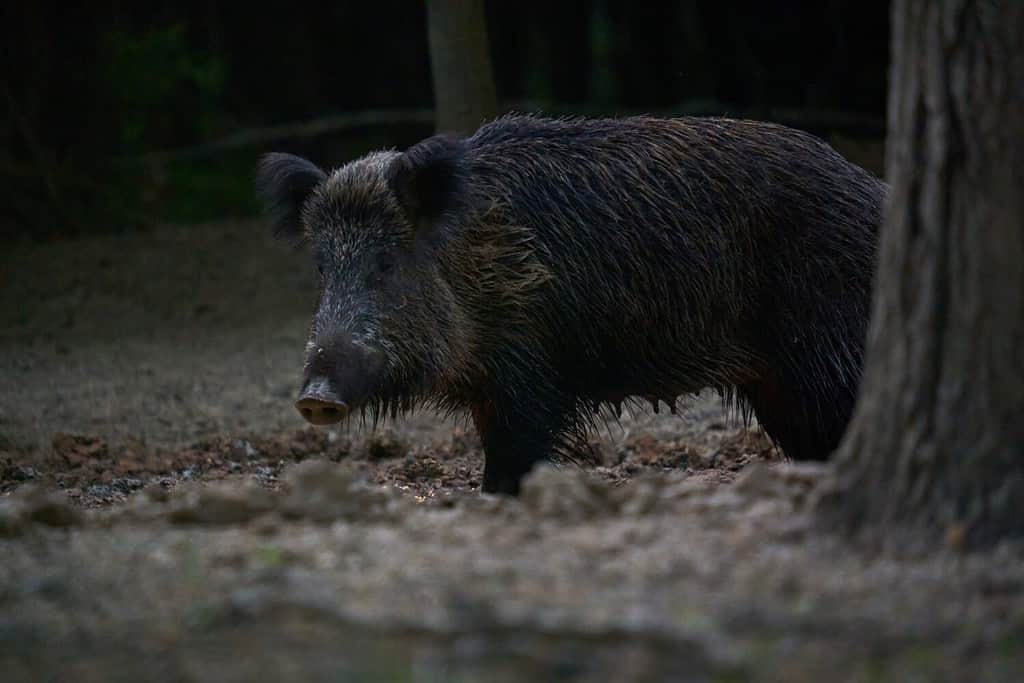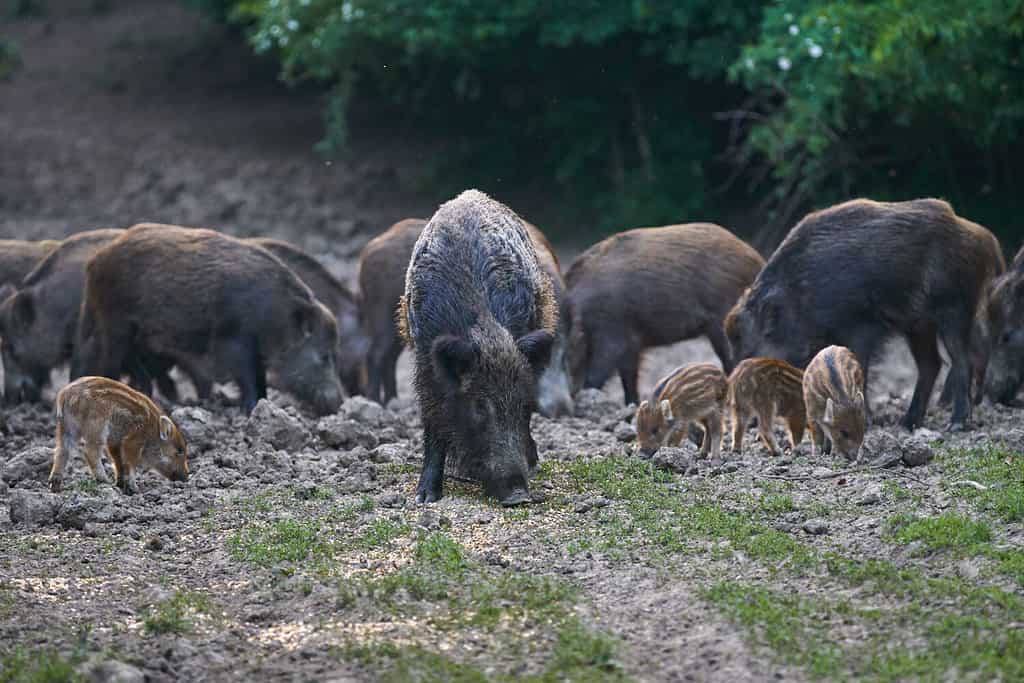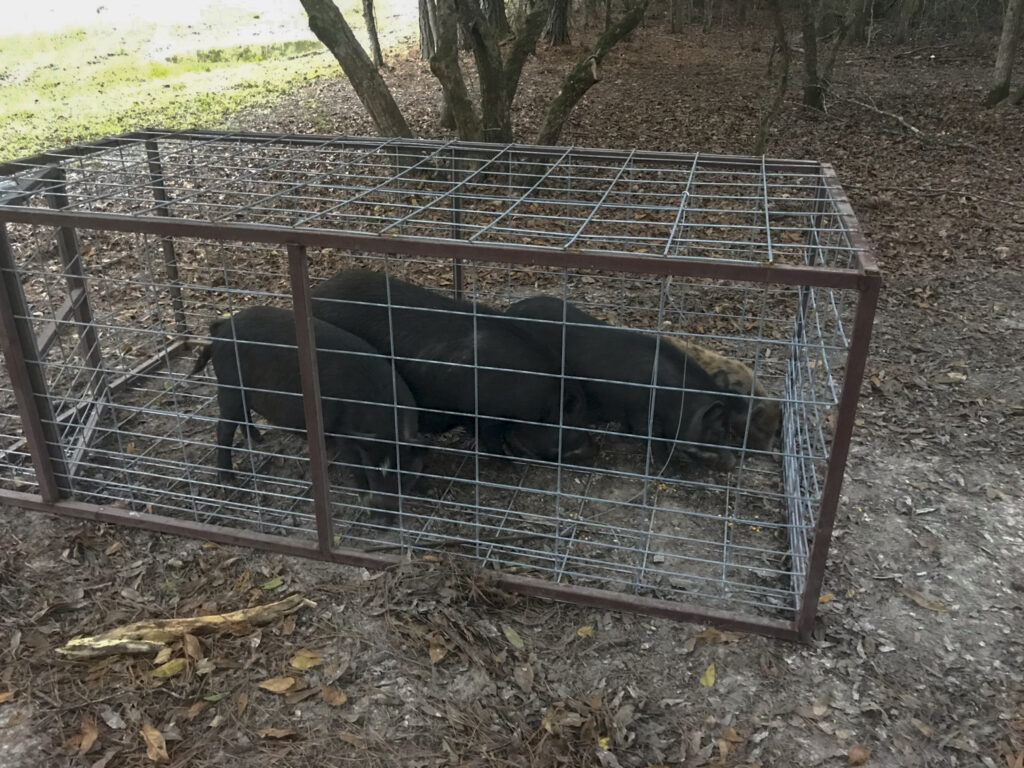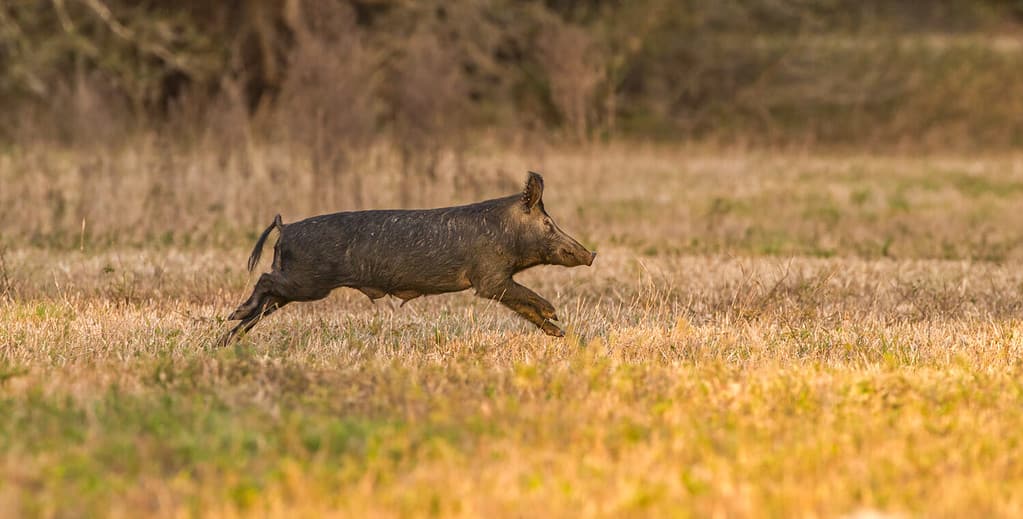Pennsylvania is home to about 3,000 wild hogs, much lower than most other states. For instance, Oklahoma has over 1.5 million feral hogs, while South Carolina has around 450,000. Compared to these numbers, 3,000 wild hogs isn’t a lot.
The state allows its small hog population to be hunted, largely because feral hogs are extremely dangerous, destructive, and invasive. There aren’t many regulations for hunting, and you do not need a license to hunt feral hogs in Pennsylvania.
Whether you’re looking to hunt or avoid these animals, you’ll mostly only find them in certain locations. They have a fairly low population, so you probably won’t see them wandering the woods.
Below, we’ll look at everything you need to know about feral hogs in Pennsylvania.

On average feral hogs are 5 to 6 feet long, measuring from snout to tail.
©Slatan/Shutterstock.com
What Are Feral Hogs?
Feral hogs are descendants of domesticated pigs adapted to live in the wild. Many individuals still exhibit traits that are common to domestic pigs. However, those with the best traits for surviving in the wild are the ones that reproduced, so feral hogs are a bit different from domestic pigs.
These animals often weigh hundreds of pounds and can sport very dangerous tusks. They have a habit of destructive behavior and will eat just about anything, which makes them dangerous animals to have in your backyard.
Introduction
The presence of feral hogs in the United States can be traced back to multiple introductions over the centuries. The initial arrivals can be attributed to European settlers who brought domestic pigs for food. As these settlers moved westward, some pigs escaped or were deliberately released into the wild, giving rise to feral populations.
While feral pigs were introduced long ago, a significant influx can be traced back to the 20th century. During this time, several individuals and hunting enthusiasts introduced feral hogs into the wild for hunting purposes. They thought that the pigs might provide new hunting opportunities and recreational opportunities. They thought that people would want to come to hunt these pigs.
However, these introductions caused several unintentional consequences. Feral hogs can reproduce very quickly. A sow can have multiple litters a year with several babies in each litter. Therefore, the population quickly grew and got out of control.
Population
Their adaptability and omnivorous diet also allowed them to live just about anywhere. The population was able to expand past the area they were introduced. Feral hogs are very good at colonizing new areas.
Today, at least 35 states have established populations of feral hogs, which means that the local population is breeding. Pennsylvania falls into this category, with around 3,000 hogs across several counties.
Destruction and Prevention
The impacts of feral hogs extend beyond their destructive nature. They have been known to damage crops, root up pastures, and disturb ecosystems by displacing native wildlife and destroying their habitats. Moreover, their rooting behavior can result in soil erosion and water pollution.
Federal and state agencies have implemented strategies to help control the feral hog population. Often, this involves hunting, trapping, and preventing more hogs from being introduced. Feral hogs do not have natural predators in many states.

The initial arrivals can be attributed to European settlers who brought domestic pigs for food.
©Slatan/Shutterstock.com
Can You Hunt Wild Hogs in Pennsylvania?
According to the U.S. Department of Agriculture (USDA), feral hogs have been reported in at least 35 states nationwide, with an estimated population of 9 million. In an attempt to control their population, hunting feral hogs is completely unregulated in Pennsylvania. While the state doesn’t have a vast population, officials are trying to keep it that way.
Feral hogs can be taken 365 days a year in Pennsylvania without a bag limit.
In the beginning, these hogs were mostly confined to game preserves. However, there are now 3,000 spread across ten different counties – with new counties constantly added. It was last updated in 2018 when Bedford, Bradford, Fulton, and Somerset counties were added.
However, feral hogs have also been seen and reported outside these counties, including Cumberland, York, Tioga, and Lancaster. The population may be much larger than officials initially estimated.
You can find feral hogs in various habitats, as they are extremely adaptive. They can live in forests, fields, wetlands, and even suburban areas. They’re very mobile and can travel long distances to find shelter and food, which is why there are often sightings throughout the state.
Are They Dangerous?
Feral hogs are dangerous, one reason keeping their population low is important.
Destructive
They are omnivores that will consume just about anything. They can destroy almost any crop, including soybeans, wheat, oats, hay, fruits, veggies, and corn. They’re a pest for many farmers in the state.
These hogs will also attack and consume animals, including livestock. They’re known for going after sheep, calves, goats, poultry, and horses.
They also compete with local animals for food and other resources. Because they are invasive, they can out-compete native animals and cause their population to decline. They also create wallows, leading to erosion, vegetation damage, degraded water quality, and the spread of invasive plants.
As you can see, they are not good for the local environment or farmers.
Diseases
Feral hogs can also harbor and spread various diseases that infect other animals and people. For instance, they’re known to spread brucellosis, pseudorabies, swine influenza, leptospirosis, salmonellosis, anthrax, tuberculosis, trichinosis, and African swine fever. That’s a lot of diseases.
These animals can also spread parasites, including ticks, fleas, lice, worms, and flukes. These parasites also carry diseases. Therefore, even if feral hogs don’t directly cause diseases like Rocky Mountain spotted fever, they can contribute to its spread.
People can contract these diseases through contact with tissues, aerosol droplets, and infected blood. These diseases and parasites can often live in the ground for a long time, infecting people when they come into contact with the dirt. These diseases can affect livestock and wildlife, too.
Direct Injury
Feral hogs can also directly harm and injure people. They are aggressive and dangerous when provoked or threatened. Their sharp tusks and hooves can seriously harm humans and other animals. They’re known for charging and attacking at high speeds without much warning.
There are many reports of hogs injuring and killing hunters, hikers, and farms. In 2019, a Texas woman was killed by feral hogs outside her home.

They create wallows, leading to erosion, vegetation damage, degraded water quality, and the spread of invasive plants.
©iStock.com/1448628063
What Can Be Done?
Feral hogs pose a serious risk to Pennsylvania’s wildlife, livestock, and people. Many organizations are trying to stop their spread across the United States, but this is an effort that requires coordination on many levels. The USDA has established the National Feral Swine Damage Management Program to provide technical assistance and help cooperation on federal, state, and local levels.
There are many ways these hogs can be controlled. Since they lack natural predators, their populations often get out of control without human intervention. Trapping, shooting, fencing, and baiting are the primary sources of population control.
The Pennsylvania Game Commission works closely with the USDA to trap and remove feral hogs from the area. This ongoing process began in 2007. The PGC also recommends hunters report any sightings of hogs to their local offices for documentation.
Because feral hogs
are an invasive species, they significantly threaten Pennsylvania’s natural resources, wildlife, agriculture, and human health. They are not native to North America at all. Instead, they were introduced by humans. Therefore, it’s part of our responsibility to ensure that don’t harm the local wildlife and land.

The Pennsylvania Game Commission works closely with the USDA to trap and remove feral hogs from the area.
©iStock.com/Tim Bingham
Advice for Pennsylvania Residents
Recognizing Feral Hog Activity
Feral hogs may be destructive and dangerous, but they are also elusive. It isn’t always easy to notice when they are in the area. They often remain hidden during the day, becoming most active at night.
However, there are several signs you can look for to identify feral hogs in your area:
- Tracks and Trails: Feral hogs leave distinctive hoof prints in muddy soil. Their tracks are usually round and symmetrical – with pointed front edges. Their trails may appear as disturbed vegetation or flattened grass, indicating their movement through an area. They usually don’t move with much grace.
- Rooting and Wallows: Feral hogs dig around for roots and other food. This behavior is very destructive but can make it easier to notice their presence. Look for ground that has been disturbed and large patches of soil that have been overturned. They also create mud depressions called wallows to cool down and mark territory.
- Crop Damage: Feral hogs will eat just about everything, including crops. They have a voracious appetite and will quickly destroy a field. They can cause significant damage to fields. Look for eaten plants, uprooted crops, and trampled fields.
- Scat and Rubbing Marks: Feral hog droppings are cylindrical in shape. They look like domestic pigs’ droppings. These droppings are often found in small groups or scattered around their feeding areas. Additionally, feral hogs may rub against trees or other objects to mark their presence, leaving behind hair and rub marks at their shoulder height.
Reporting Sightings
If you suspect feral pigs are in your area, you must report it to the appropriate authorities. Federal, state, and local governments cannot keep these populations in check if they don’t know they exist. Most of their work is held up by local population sightings from landowners and hunters.
Contact your local Pennsylvania Game Commission (or similar organization) to report these sightings. They often have experts that can assess the situation and provide guidance or intervene directly.
When you call, be sure to provide as much information as possible. Gather evidence of the sighting, including the location, date, and time. Take pictures if you can. The more information you have, the more they can help.
Be sure to follow the specific reporting protocols provided by the authorities. They may require you to fill out a form, provide additional documentation, or direct you to designated reporting channels.
Small local offices may not have the staff to handle these reports directly. Therefore, they may direct you to the proper state organization that handles feral hogs.
Precautionary Measures
Encountering feral hogs in Pennsylvania is pretty rare. These animals prefer to keep to themselves and don’t like conflict. However, it’s still important to reduce your risk, especially if you know they’re in your area.
Feral hogs are attracted to easily accessible food, so securing waste and food sources is important. These include garbage, compost, and spilled grains. Ensure that trash cans have secure lids and avoid leaving food or food waste in areas accessible to wildlife. Properly store livestock feed and secure it in sturdy containers.
Agricultural fields, orchards, and gardens often fall in this “easily accessible food” category, so you’ll need to secure them, too. Consider installing sturdy fences to deter feral hogs from accessing these areas. These fences must be 3-4 feet high and constructed with materials that can withstand a several-hundred-pound animal.
Usually, heavy-gauge wire mesh or electric fencing is used.
Most hog encounters occur in the woods. Therefore, when exploring natural areas, you should remain vigilant and look for feral hog activity. Avoid dense vegetation and areas with fresh rooting or wallows. If you encounter feral hogs, keep a safe distance and do not approach them. It’s best to quietly and calmly retreat from the area.
While avoiding feral hogs isn’t difficult, most encounters and attacks occur because basic procedures aren’t followed (like those described above). Share this information with your children, friends, and neighbors.
What U.S. States Allow Feral Hog Hunting?

Feral hog hunting is allowed in 28 U.S. states.
©Chase D’animulls/Shutterstock.com
There are a number of states that allow hunters to target feral hogs alongside Pennsylvania–a total of 28 in all. Of those, certain ones allow year-round hunting of them. The other states have either outlawed hunting of these beasts, or they don’t have a significant population. The states that allow feral hogs to be hunted, along with the estimated population of hogs per state, are as follows:
- Alabama (250,000)
- Arkansas (200,000)
- California (400,000)
- Florida (500,000)
- Georgia (600,000)
- Hawaii (600,000)
- Idaho (<100)
- Illinois (unknown)
- Indiana (<1,000)
- Iowa (<1,000)
- Kentucky (2,000)
- Louisiana (750,000)
- Michigan (5,000)
- Mississippi (200,000)
- New Hampshire (unknown)
- New Jersey (<1,000)
- New Mexico (500,000)
- North Carolina (100,000)
- Ohio (2,000)
- Oklahoma (1.5 million)
- Oregon (5,000)
- Pennsylvania (3,000)
- South Carolina (450,000)
- Tennessee (unknown)
- Texas (3.0 million)
- Virginia (3,000)
- West Virginia (<1,000)
- Wisconsin (<1,000)
The top 5 states considered the best for feral hog hunting due to their extreme populations are Texas, Oklahoma, Louisiana, Georgia, and Florida.
The photo featured at the top of this post is © WildMedia/Shutterstock.com
Thank you for reading! Have some feedback for us? Contact the AZ Animals editorial team.






